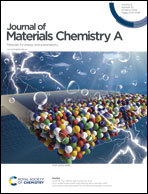Surface decoration on self-supporting high entropy alloy electrodes for enhanced electrochemical water splitting†
Abstract
The development of mechanically robust and electrochemically active high-performance electrodes is essential for the electrocatalytic process, thus reducing the energy input and achieving excellent environmental tolerance. In this case, high-entropy alloys, as a rising star with excellent mechanical stability and electrochemical performance, can be applied as both structural and functional electrodes in the field of conversion and storage. Herein, a high-entropy alloy electrode with hierarchically porous structure (PHEA) was designed and fabricated via the selective etching of a eutectic two-phase microstructure. Compared with commercial nickel foam (NF) as an electrocatalyst substrate, PHEA possessed better mechanical robustness, larger specific surface area, more favorable electrocatalytic activity and long-term stability. Subsequently, a surface modification strategy was proposed to decorate the PHEA substrate via a facile noble-metal-doped-layered double hydroxide (LDH) regulating route. Electrochemical measurements showed that the PHEA electrode modified with trace-noble-metal-doped-LDH exhibited excellent catalytic activity and stability, with overpotentials of 21 and 227 mV at a current density of 10 mA cm−2 for the hydrogen evolution (HER) and oxygen evolution reaction (OER), respectively. The X-ray photoelectron spectra and in situ FT-IR spectra indicated that the successful doping of Pt contributed to the enhancement in the HER performance, and the in situ Raman spectra revealed the structural transformation on the catalyst surface during the OER process. Surprisingly, long-term stability at an ultrahigh industrial-level current density (∼1 A cm−2) was observed when employing the bifunctional LDH@PHEA electrode assembly in an overall water splitting device. This work explored the advantages and application of PHEA as a versatile electrocatalyst substrate, thus providing new insights and approaches for designing and constructing robust porous electrodes via surface modification towards efficient hydrogen generation.

- This article is part of the themed collection: Journal of Materials Chemistry A HOT Papers


 Please wait while we load your content...
Please wait while we load your content...